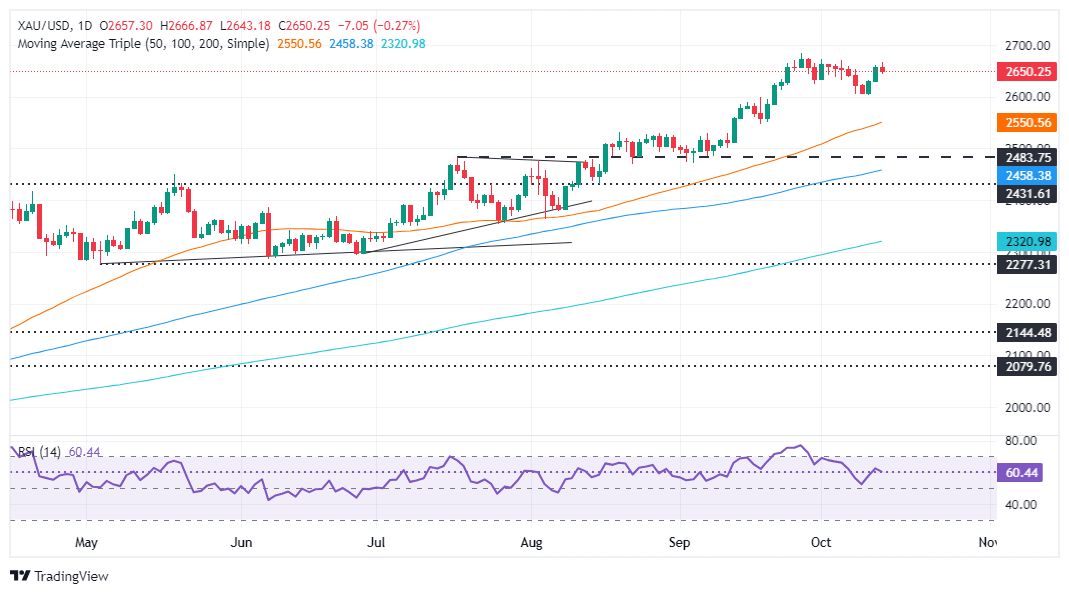- Gold falls as China’s stimulus efforts fail to ease deflationary pressures.
- Minneapolis Fed President Kashkari’s comments on modest rate cuts and a strong labor market further support the dollar.
- Geopolitical tensions, including Israel’s response to Hezbollah and Iran, continue to weigh on gold prices, with traders eyeing US economic data later in the week.
Gold price retreats after hitting a daily high of $2,666 on Monday as China’s stimulus failed to provide relief to financial markets and the dollar extended its advance. XAU/USD is trading at $2,650, down 0.26% at the time of writing.
Over the weekend, data revealed that China’s economy is facing deflationary pressures that threaten to derail it from the 5% Gross Domestic Product (GDP) target. In this sense, Chinese Finance Minister Lan Foan announced that the government will continue to provide stimulus, support the real estate market and replenish capital in state banks to boost the economy.
Meanwhile, the US bond market remains closed in observance of Columbus Day, however, Gold prices fell amid a strong Dollar.
The US Dollar Index (DXY), which tracks the value of the dollar against a basket of six currencies, rose 0.38% to 103.30, its highest level since early August 2024.
Earlier, Minneapolis Fed President Neel Kashkari revealed that he expected “modest future reductions in our policy rate.” He added that recent employment data shows a strong labor market and that the economy is finally bringing inflation back to 2%.
Meanwhile, geopolitics will continue to play a role in pricing the yellow metal. News reveals that Israel has started a security meeting to decide its response to the Iran and Hezbollah attacks in Tel Aviv.
This week, the US economic calendar will include the New York Empire State Manufacturing Index on Tuesday, followed by the Trade Balance on Wednesday. Members of the Federal Reserve (Fed) will also speak throughout the week.
Daily Summary of Market Drivers: Gold Price Traders Pending Key US Economic Data
- On Tuesday, according to estimates, the New York Empire State Manufacturing Index for October is expected to fall from 11.3 to 2.3.
- Fed officials including San Francisco Fed President Mary Daly, Council Governor Adriana Kugler and Atlanta Fed President Raphael Bostic are expected to make public statements.
- The combination of a slightly higher Consumer Price Index (CPI) and a weak US jobs report on Friday could lead to additional rate cuts by the Fed.
- The US 10-year benchmark bond yield remains above the 4% threshold amid declining odds of more aggressive Fed policy easing.
- Data from the Chicago Board of Trade, based on the December federal funds rate futures contract, indicates that investors are pricing in a 46 basis point (bps) easing by the Fed towards the end of 2024.
XAU/USD Technical Outlook: Gold Price Falls Towards $2,650
The bullish trend in Gold price remains intact despite retracing from around $2,660 towards the $2,650 area. Momentum is bullish, as shown by the Relative Strength Index (RSI), although the RSI is heading slightly lower, an indication that some selling pressure remains.
If XAU/USD falls below $2,650, it could open the way for a further decline. The next key support level would be $2,600. A break of the latter will expose the 50-day SMA at $2,555.
On the contrary, if
Gold FAQs
Gold has played a fundamental role in human history, as it has been widely used as a store of value and medium of exchange. Today, apart from its brilliance and use for jewelry, the precious metal is considered a safe-haven asset, meaning it is considered a good investment in turbulent times. Gold is also considered a hedge against inflation and currency depreciation, since it does not depend on any specific issuer or government.
Central banks are the largest holders of Gold. In their aim to support their currencies in turbulent times, central banks tend to diversify their reserves and purchase Gold to improve the perception of strength of the economy and currency. High Gold reserves can be a source of confidence for the solvency of a country. Central banks added 1,136 tons of gold worth about $70 billion to their reserves in 2022, according to data from the World Gold Council. This is the largest annual purchase since records exist. Central banks in emerging economies such as China, India and Türkiye are rapidly increasing their gold reserves.
Gold has an inverse correlation with the US Dollar and US Treasuries, which are the main reserve and safe haven assets. When the Dollar depreciates, the price of Gold tends to rise, allowing investors and central banks to diversify their assets in turbulent times. Gold is also inversely correlated with risk assets. A rally in the stock market tends to weaken the price of Gold, while sell-offs in riskier markets tend to favor the precious metal.
The price of Gold can move due to a wide range of factors. Geopolitical instability or fear of a deep recession can cause the price of Gold to rise rapidly due to its status as a safe haven asset. As a non-yielding asset, the price of Gold tends to rise when interest rates fall, while rising money prices tend to weigh down the yellow metal. Still, most of the moves depend on how the US Dollar (USD) performs, as the asset is traded in dollars (XAU/USD). A strong Dollar tends to keep the price of Gold in check, while a weaker Dollar is likely to push up Gold prices.
Source: Fx Street
I am Joshua Winder, a senior-level journalist and editor at World Stock Market. I specialize in covering news related to the stock market and economic trends. With more than 8 years of experience in this field, I have become an expert in financial reporting.








